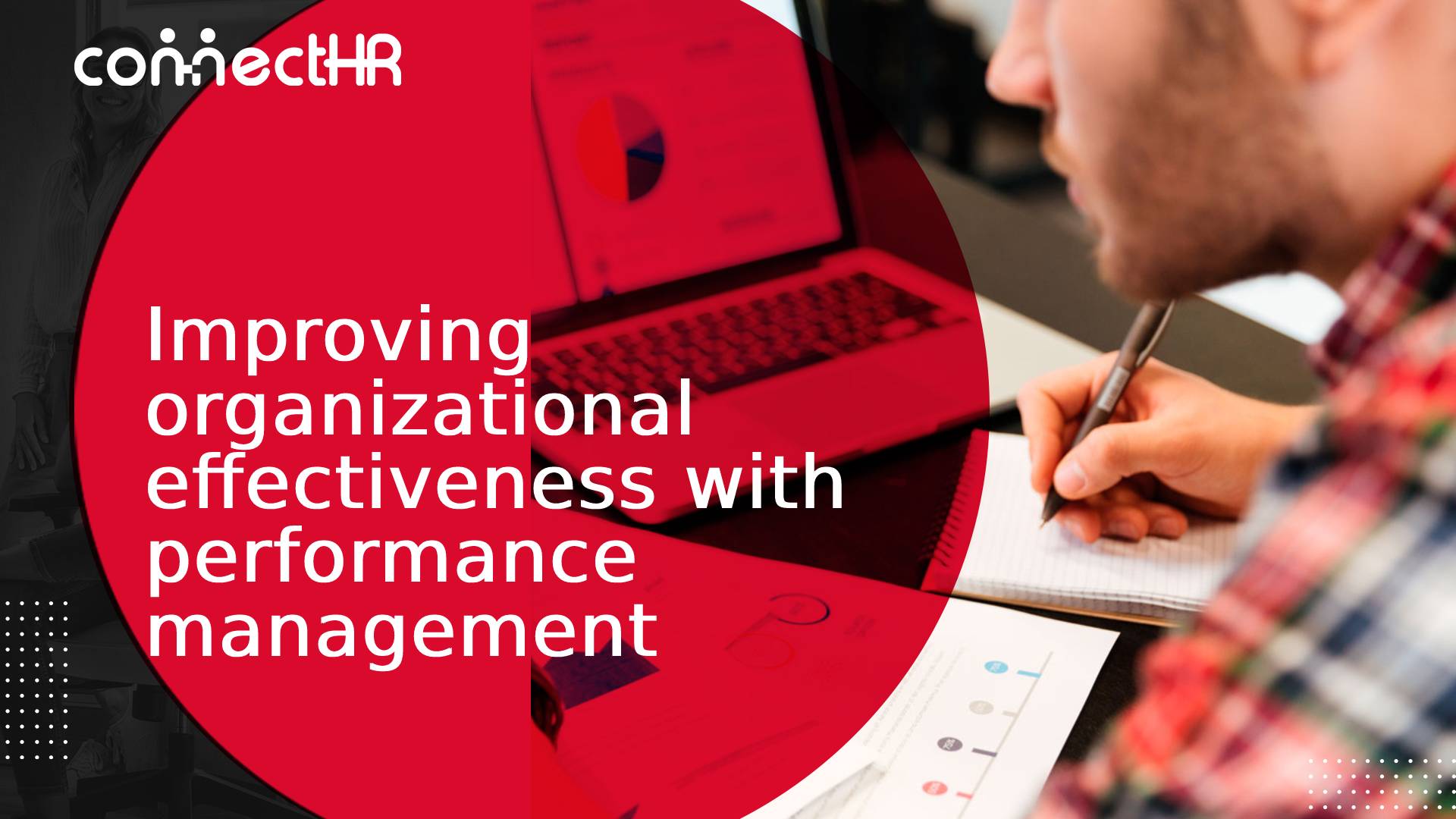Performance management assists firms in analyzing, enhancing, and rewarding the performance of their workforces. This methodology helps firms achieve their goals and helps their workers attain their full potential. This validates why it is a developing trend and why we see more firms employing employee management systems.
Today’s article will provide you with a quick approach to increase organizational effectiveness with performance management. We will also discuss management processes that will benefit your firm. As well as the variations between performance management and employee performance evaluation. These are the topics to analyze:
- What is performance management?
- Is performance management important for our company?
- What is performance evaluation?
- How do performance management and performance evaluation differ?
- Which are the phases of performance management?
- Top 5 strategies to implement effective performance management in your company
- ConnectHR is your partner in achieving the proper performance management.
1. What is performance management?

It refers to the practice of ongoing feedback and communication between managers and their staff. Thanks to this, they assure the firm’s strategic objectives. To summarize, excellent performance management focuses on enhancing the abilities that assist an individual execute their job better.
The definition of this term has evolved since it originally surfaced as a concept. What was formerly an annual procedure is now changing to continuous performance management. The purpose is to guarantee that staff is performing efficiently throughout the year. Therefore, in the process, any issues that may occur along the way that companies may address impact employee performance.
HR automation now plays a crucial part in performance management. Many of the procedures involved may be reduced so that employee performance can be strategically controlled. This is the performance management system era, but there is much to know about. Many aspects, such as the digital age, are present now; therefore, this practice evolves.
Even if you do not realize it, your firm has a performance management system. Because, generally, all organizations alter functions to better the management of their staff. The difficulty is that things might go wrong by not being attentive or not having the correct methods. Not just harming the employees, but the firm itself.
2. Is performance management important for our company?
Following the preceding, performance management in HR should aid both the organization and the employees. The relevance of these processes rests in the fact that it is the most effective technique to impact workers’ job performance. Thus aiding to accomplish or surpass the desired objectives.
But workers can also profit from installing an intelligent performance management system. The availability of assessment indicators, for example, encourages workers to be more efficient in their activities. Meanwhile, workers know exactly what the corporation wants of them.
To employees, ongoing performance management suggests that supervisors appreciate them. Employees feel that their supervisors engage in their job and care about their ambitions. As well as any challenges they may experience in their profession. In this way, individuals also grow more receptive to hearing critical comments.
This is why employee performance evaluation software deployment is vital in 2022. It is a critical element in every digital transformation strategy and an obligatory step to optimize such a sensitive operation to the utmost. As a performance management process, assessors have consolidated access to all employee information at all times.
3. What is performance evaluation?
Performance evaluation is one of the most regularly employed methodologies in organizations. It assesses the professional conduct, performance, productivity, and competencies of personnel. The whole process of performance evaluation is carried out comprehensively and objectively. This is so because any prejudice would lead to erroneous findings or be incapable of benefitting decision-making.
The purpose is to know what each individual does, the outcomes they achieve, and how they work. Companies may set up a complete profile strongly tied to productivity in this approach. In addition, this evaluation may be created at many levels and acquire all sorts of data. The old technique assessed that each employee’s expectations were being fulfilled.
Over time, more analyses have been incorporated, such as the worker’s abilities and aptitudes. As well as the capacity to relate to their peers and other intriguing criteria to gauge achievement. In the latter instance, each organization may customize the evaluation to its own needs and grow inaccuracy.
Also, companies can measure labor metrics as long as they give helpful information to the business and its progress. Thus, companies might use the data obtained to solve several corporate problems. For example, internal conflicts, enhancing the work environment, or assessing the needs of both teams and individuals.
4. How do performance management and performance evaluation differ?
Companies can realize that this process, as well as employee performance evaluation are similar ideas. This is partly accurate, but in actuality, each statement relates to various parts of talent management. A performance management process is a worldwide approach where evaluation is merely another pillar.
Within the performance management system, a range of features is incorporated, such as the supervision of evaluation procedures. As well as planning activities to maximize the performance of the workforce and advances in the management of human talent. It covers a substantial part of its productivity management when used with the correct tactics.
Performance evaluation is likely the most visible and significant duty in performance management. This covers the precise tests for measuring work performance and the deadlines and circumstances. For example, this also involves giving feedback to staff to enhance their performance.
Companies can use different tests to monitor and evaluate their staff’s performance and examine their abilities and skills. In turn, there are appraisal systems that estimate the projection and potential of each worker. The purpose is to accurately follow the flowchart of the phases of the performance management system and obtain a productivity boost.
5. Which are the phases of performance management?
As in any other long-term plan, performance management contains distinct phases, the duration of which is impossible to determine. This cycle is a set of five significant steps. These measures are critical, regardless of how regularly you analyze employee performance.
These phases are positioned in a schematic that has been improved throughout the years. Following each of these measures ensures the organization a successful performance management system. Since it permits creating methods for the correct management and boosting the productivity of the same one. Here are the five stages to take into account.
5.1 Planning
This step comprises setting workers’ goals and sharing these goals with them. In comparison, these aims should be specified in the job description and conveyed when the candidate becomes a recruit. Depending on the management system in your firm, you will have to allocate a percentage to each target. In this method, you will be able to evaluate their achievement.
5.2 Monitoring
In this phase, supervisors are needed to monitor the employee’s performance on the target. This is where continuous performance management enters into the picture. With the proper software, you can track your team’s performance in real-time alter and correct course if necessary.
5.3 Developing
This phase comprises using the data gathered during the monitoring phase to enhance the performance of personnel. It may need to offer refresher classes, helping them improve their knowledge and performance on the job. Or possibly, modifying the trajectory of staff development to boost performance or preserve excellence.
5.4 Rating
Each worker’s performance must be rated frequently and then at the performance evaluation time. Ratings are necessary to determine the status of employee performance and execute adjustments accordingly. Both peers and supervisors can submit these evaluations for 360-degree feedback.
5.5 Rewarding
Recognizing and rewarding strong performance is fundamental to performance management and a critical aspect of employee engagement. You may accomplish this with a simple thank you, social recognition, or a full-scale staff incentives program. In this approach, you may frequently recognize and reward good performance in the organization
6. Top 5 strategies to implement effective performance management in your company
Business and HR executives may enable people to achieve by building a performance management system. This works best for employees and the company’s business procedures. Still, it might be difficult for worldwide corporations with operations in various countries.
In these cases, programs can be established using broad recommendations. In these cases, performance management programs may be specified using basic parameters to suit the business and allow for unique practices for each location. This helps organizations to design more precise and relevant employee management systems.
Performance management is vital nowadays, but specific techniques must be followed or tailored to the firm to achieve it. Even though many management procedures flow easily, companies must take these tactics into mind. Here are five critical techniques to develop an effective performance management system.
6.1 Real-time communication
Business leaders may boost cooperation by offering tools and processes to exchange feedback and changes in real-time. This is especially relevant nowadays as many firms embrace remote work or hybrid work settings.
Encouraging employees to exchange knowledge often and seek clarification has a beneficial influence on the work culture. This also helps eliminate delays between teams and departments.
6.2 Develop practical and effective plans
Even the best organizational plans are pointless unless someone takes action. Objectives developed at all firm levels must be appropriately connected to individual performance plans. This may be a very tough procedure, but it is worth the effort to explain who is responsible for specific responsibilities.
Development plans should also incorporate feasible targets. Companies should also transform feedback acquired throughout the employee performance management cycle into functional changes and activities.
6.3 Leverage technology and data
Each employee has distinct demands and individual opinions on work and life. When you include interpersonal behaviors that arise from team and department structures, comprehending the environment may be highly difficult.
Fortunately, HR technologies such as contemporary software platforms and workforce analytics solutions, are advantageous to the organization. They can assist companies in understanding the dynamics that impact performance and discover the elements that drive high-performance behaviors.
6.4 Improve the workplace design
Employee performance management is a holistic endeavor and should not simply focus on the people themselves. In addition, other factors such as office design, business culture, and remote work regulations can substantially influence performance.
Take the effort to enhance your office design and provide staff multiple options to communicate and cooperate. Cross-functional workshops are a fantastic method to bring people together in complicated firms with numerous layers of management.
6.5 Monitor company failures
Identify failures and monitor them to determine how you are producing them. Identify chances to coach and mentor and establish a feeling of accountability among all workers. Change unsettles many individuals, but you may lessen worries in a very dynamic way.
You might establish a plan that needs managers’ engagement in the advancement and development of their positions; make your managers mentors. When bad performance rises, see it as a chance to establish a stronger team.
7. Connect HR is your partner in achieving the proper performance management
Performance management is supported by HR, but the entire business must make the process operate efficiently. If you want to optimize the productivity of our organization, you must keep performance management into mind. The numbers are crucial; every individual in the organization is just as significant.
How they feel within the firm is a priority since it is reflected in its productivity. The implementation of the tactics mentioned above can assure correct performance management. If you want to enhance employee effectiveness at your business, Connect HR is the right partner with more than 20 years of expertise in the business field.
Connect HR’s employee benefits and HRMS services offer you a seamless road to successful performance management. As one of the leading firms in the UAE, it is the right partner for efficient management. Do not get left behind, and take a step towards the future with Connect HR.
Would you like to contact Connect HR to obtain more information about our company’s performance management services? If you have any questions, send us an email to [email protected]
Want to work with us? Please go to thetalentpoint.com and upload your resume or CV. Sent CVs and resumes, [email protected]. We are waiting for you!





